Part 1 of this FAQ looked at the overall context of wireless charging of personal devices. This part looks in more detail at the approaches to wireless charging and the implementation specifics.
Q: What approaches are available for wireless charging?
A: There are three basic topologies: single-coil inductive, multi-coil inductive, and resonant.
Q: What are their main characteristics?
A: Single-coil inductive is the simplest and most common, at present. It uses a single transmitter coil and requires close positioning between the power source and the device being charged. In contrast, the multi-coil method can charge a device placed almost anywhere on a broad surface, due to the multiple coils, Figure 1; it detects which coil is closest to the device to be charged and directs transmitted power accordingly.
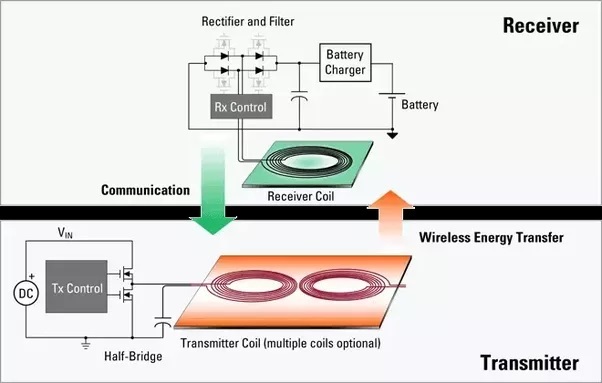
The resonant approach uses the principle of magnetic resonance between source and receiver for higher efficiency and greater distance, up to about 50 mm. The inductive approach is simplest and works best in a controlled, well-defined positioning situation, at a cost in placement freedom; the resonant approach allows more freedom but at greater cost. The resonant approach can also deliver more power, and so is a better fit for laptops and even small power tools, or applications such as automobiles, Figure 2.
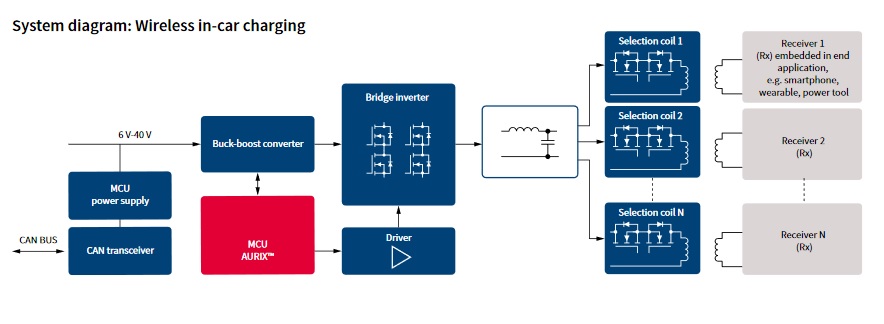
Q: Is that all there is to it?
A: The preceding is only a glimpse at the bigger story. Single-coil inductive is based on basic, well-known magnetic coupling principles between primary and secondary windings of an air-core transformer (no ferrous core). The amount of power transferred and the overall efficiency of the process is a function of the alignment coupling and distance between coils, with a typical coupling coefficient in the 0.3 – 0.6 range.
Performance and energy-transfer efficiency can be improved by using resonant circuits with the primary and secondary-side coils. This is most easily done by adding a capacitance (C) to the inherent inductance (L) of the coil, thus forming a resonant LC “tank” circuit.
Q: That works near field, but what about far-field power transmission?
A: Unlike the magnetic-only coupling of a near-field situation, the far-field approach is more akin to radio. The transmitter antenna creates both electric and magnetic fields at right angles to one another, and which travel through space. When they reach the receiver, that antenna captures some of the signal energy and generates a small useful voltage. However, as is also well known, power level drops off with the square of the distance between transmitter and receiver. Therefore, the distance must be kept short, and the antennas at one or both ends should be somewhat directional. This increases effective radiated and captured power but restricts broader angular coverage. Figure 3 summarizes the attributes of each mode.
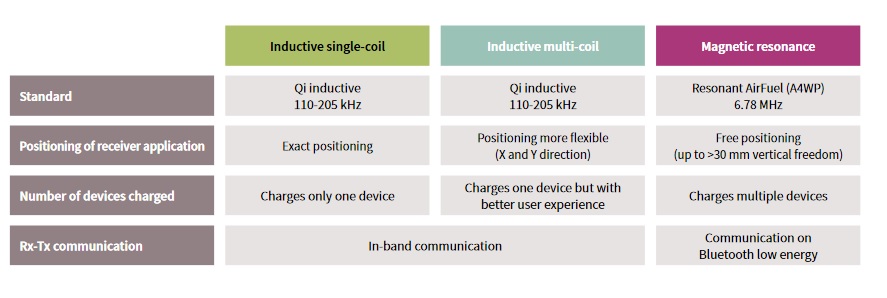
Q: What about wireless-charging standards?
A: That’s a very important issue and factor in determining the success and acceptance of wireless charging. A widely used standard is called Qi (pronounced “chee”), which was developed by the Wireless Power Consortium (WPC), which tests and certifies compatible inductive and resonant devices (analogous to what the Wi-Fi Alliance, Bluetooth SIG, and Zigbee Alliance do). The Qi standard supports three basic power levels: 0 to 5 W, 0 to 15 W, and 0 to 120 W, with the low-power versions using separation of 5 mm to 40 mm. The resonant coupling is typically done at 140 kHz but can be between 110 and 205 kHz, and there is also a data-communications link between the transmitter and receiver, so the receiver can signal its power needs and status to the transmitter at a modest but adequate 2-kbps rate.
A competing but less widely used standard is supported by the AirFuel Alliance, formed by the 2015 merger of the Alliance for Wireless Power (A4WP) and Power Matters Alliance (PMA); this alliance also tests and certifies compliant devices. The AFA approach allows charging of multiple devices simultaneously. This resonant standard supports six classes of power levels from 2 to 70 W, with resonant-coil separation up to 50 mm, at a frequency of 6.78 MHz. Coil alignment is less critical, and the status link between transmitter and receiver uses BLE (Bluetooth Low Energy) at up to 1 Mbps.
Q: What’s the outlook for wireless charging?
A: As in all these market forecasts, the numbers answers vary widely and have impossible-to-assess credibility, and market research firms tend to be naturally upbeat and optimistic. Technavio predicts that the market will grow by more than 33% from 2015 to 2020, admittedly from a small base at present. Another firm, ABI Research, sees over 700 million wireless chargeable devices by 2020. About 10% of smartphones presently include some form of wireless charging capability, which is significant or not, depending on your perspective.
Whether these longer-range forecasts are even “in the ballpark” will only be known after 2020, as there are many factors pro and con to wires charging including cost, weight, complexity, and device/charger compatibility. No one knows if wireless charging will become a mainstream interface interconnect similar to USB or Wi-Fi, or a specialty solution which in many cases creates more hassle, confusion, and headache than the problem it attempts to solve.
Q: Who are the IC vendors supporting wireless charging? Why?
A: While wireless charging requires passive components such as coils and capacitors, it also requires a considerable amount of electronic components (discrete devices and ICs) to create, manage transmission, receive, and extract the power. Issues of resonant circuitry, power management, and link control exist, all of which will require power, data, RF, and tuned-circuit management.
The list of supporting vendors for the various standards is lengthy, since wireless charging certainly is a good opportunity, and many of the required electronic disciplines which are needed are already areas of expertise for these companies. Among the vendors supporting one or all standards, via single-standard or multi-standard ICs) are nearly all of the well-known suppliers of ICs for power, signal, and RF management. The respective websites of the standards organizations list the many IC and non-IC supporters.
References
Infineon Technologies, “Wireless charging solutions”
EE World, “Wireless charging: Will the exception soon become the rule?”
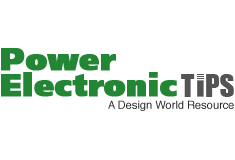

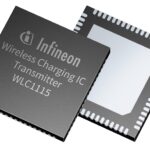
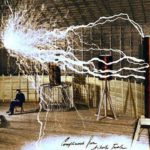


Leave a Reply